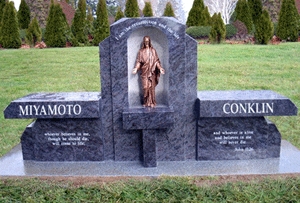 Throughout history, religious art has found its way onto headstones, grave markers, and memorials all around the world. This four-part series takes a close look at the symbolism and meaning behind this use of religious art to commemorate and celebrate the lives of those we love.
Throughout history, religious art has found its way onto headstones, grave markers, and memorials all around the world. This four-part series takes a close look at the symbolism and meaning behind this use of religious art to commemorate and celebrate the lives of those we love.
Part 1: Catholic Religious Art
With familiar symbols and easily distinguishable designs known across many different cultures, Catholic religious art has been used to adorn headstones, grave markers, and memorials for centuries. Here are some of Catholic religious art’s most significant symbols and their related meanings:
- Cross: Probably the most famous symbol of Catholic religious art, the cross figures as a symbol of Christ’s sacrificial death and resurrection in order to restore the broken relationship between a loving God and His fallen creation. Some Catholic crosses leave Christ’s body hanging on the cross. Crosses such as these are known as crucifixes. With regard to its use on headstones, grave markers, and memorials, the cross most likely symbolizes that the deceased was a Christian, as well as his or her hope of new life in heaven.
- Fish: Another recognizable Catholic symbol, the fish was how early Christians identified one another during centuries of intense Roman persecution. Some fish might also include five Greek letters, which translate to "Jesus Christ, God’s Son, Savior.” On headstones, grave markers, and memorials, the fish most likely functions to make a statement about the deceased’s beliefs.
- Dove: Though less known, the dove plays an important role in Catholic religious art, as it symbolizes the Holy Spirit. When used on headstones, grave markers, and memorials, however, the dove typically represents both peace and grace.
- Alpha and Omega: The first and the last letters of the Greek alphabet, the Alpha and the Omega symbolize that Christ is "the first and the last.” This means that He was present at creation and that He will be present at the end of time. On headstones, grave markers, and memorials, the Alpha and the Omega usually symbolize the deceased’s belief in Christ’s presence with him or her, even in death.
Catholic religious art features many more symbols than those mentioned here, but these brief explanations will hopefully enable you to understand their meanings when you see these symbols on headstones, grave markers, and memorials, or when you’re wondering how best to commemorate and celebrate the lives of those you love.

